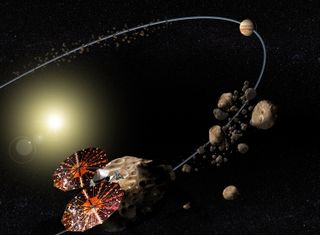
The first mission to visit a mysterious swarm of asteroids that circle the sun along Jupiter's path has cleared an important hurdle on the way to its 2021 launch.
NASA's robotic Lucy mission, which will visit six Trojan asteroids during its operational life, passed its critical design review (CDR) on Friday (Oct. 18), agency officials just announced.
During the four-day CDR, independent experts assessed all aspects of Lucy's design, ultimately deeming the mission fit to proceed to the manufacturing phase.
Related: Photos: Asteroids in Deep Space
"This is a very exciting time for us, because we are moving beyond the design phase and are really starting to build the spacecraft," Lucy principal investigator Hal Levison, from the Southwest Research Institute in Boulder, Colorado, said in a statement Monday (Oct. 21). "It is finally becoming real!"
The Trojan asteroids orbit the sun in two clumps, one ahead of Jupiter (the "leading swarm") and one behind the gas giant (the "trailing swarm"). Scientists think these space rocks are leftover relics from the long-ago formation of the outer planets, so they're eager to get some close-up looks.
"These primitive bodies hold vital clues to deciphering the history of the solar system, and perhaps even the origins of life and organic material on Earth," NASA officials wrote in a Lucy mission description.
Get the Space.com Newsletter
Breaking space news, the latest updates on rocket launches, skywatching events and more!
If all goes according to plan, Lucy will launch in October 2021, zoom past Earth twice for "gravity assists" and fly by its first asteroid in April 2025. That rock, known as (52246) Donaldjohanson, lies in the main asteroid belt between Mars and Jupiter.
Lucy will then fly by four Trojans in the leading swarm, with the rendezvous occurring in August 2027, September 2027, April 2028 and November 2028. The spacecraft's orbit will bring Lucy back toward the sun, and when it heads outward again, it will be on a trajectory toward the trailing swarm. The probe will cruise past a trailing-swarm binary Trojan in March 2033, marking the mission's grand finale.
No other space mission has ever visited so many different destinations in independent orbits, Lucy mission team members have said.
The mission's name, by the way, is a nod to the famous, 3.2-million-year-old hominid fossil discovered in Ethiopia in 1974 by paleontologists Donald Johanson and Tom Gray. (The Lucy team named after Johanson the main-belt asteroid that the probe will visit.)
Just as discovery of the fossil Lucy shed considerable light on humanity's origins, the Lucy spacecraft will reveal key insights about the solar system's early years and evolution, mission team members have said.
Lucy is part of NASA's Discovery Program of low-cost, focused planetary exploration missions. Lucy's development costs are capped at about $450 million, NASA officials said.
Other Discovery missions include the InSight Mars lander, Kepler planet-hunting space telescope, Messenger Mercury spacecraft and Dawn probe, which orbited the dwarf planets Vesta and Ceres. Another Discovery mission called Psyche is scheduled to launch in 2022, to explore the mysterious metallic asteroid of the same name.
- Asteroid Basics: A Space Rock Quiz
- Centaurs Rising: NASA Eyes Missions to Weird Asteroid-Comet Hybrids
- Our Solar System: A Photo Tour of the Planets
Mike Wall's book about the search for alien life, "Out There" (Grand Central Publishing, 2018; illustrated by Karl Tate), is out now. Follow him on Twitter @michaeldwall. Follow us on Twitter @Spacedotcom or Facebook.
Join our Space Forums to keep talking space on the latest missions, night sky and more! And if you have a news tip, correction or comment, let us know at: community@space.com.

Michael Wall is a Senior Space Writer with Space.com and joined the team in 2010. He primarily covers exoplanets, spaceflight and military space, but has been known to dabble in the space art beat. His book about the search for alien life, "Out There," was published on Nov. 13, 2018. Before becoming a science writer, Michael worked as a herpetologist and wildlife biologist. He has a Ph.D. in evolutionary biology from the University of Sydney, Australia, a bachelor's degree from the University of Arizona, and a graduate certificate in science writing from the University of California, Santa Cruz. To find out what his latest project is, you can follow Michael on Twitter.
